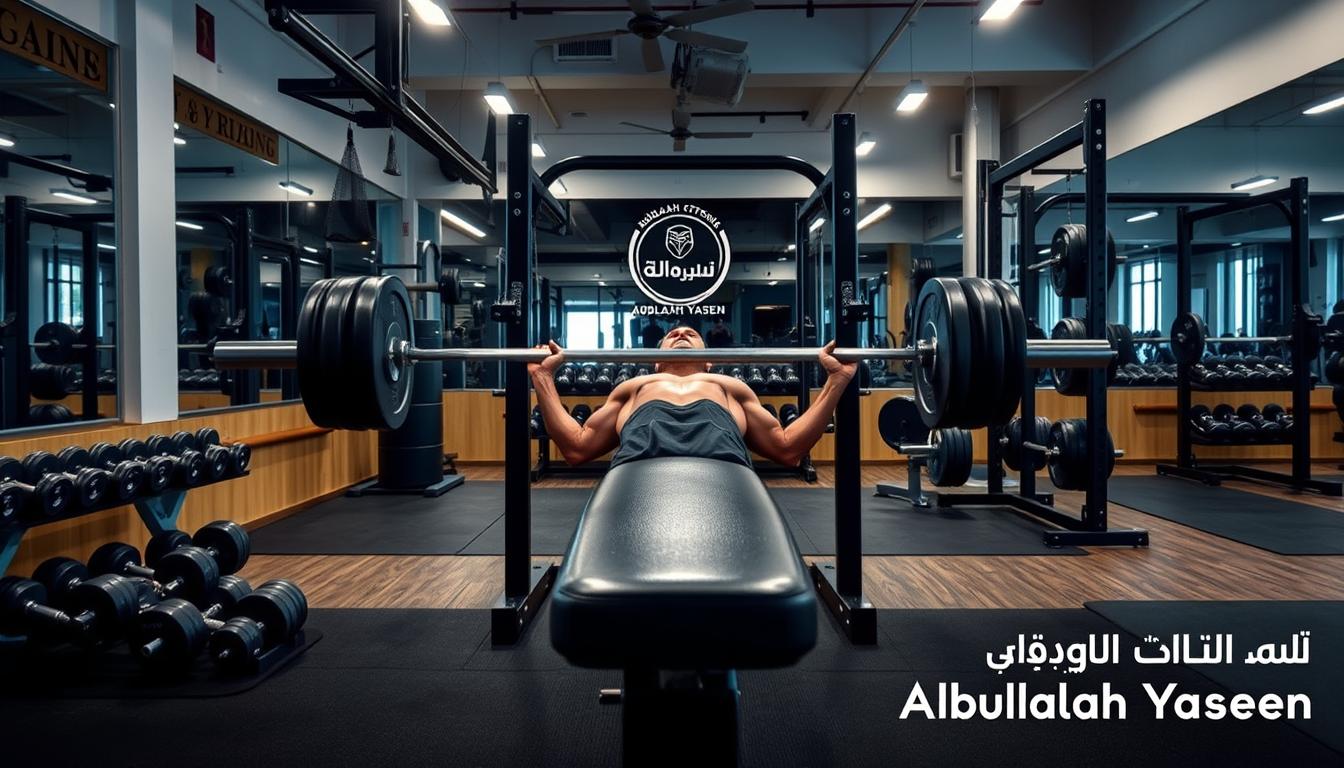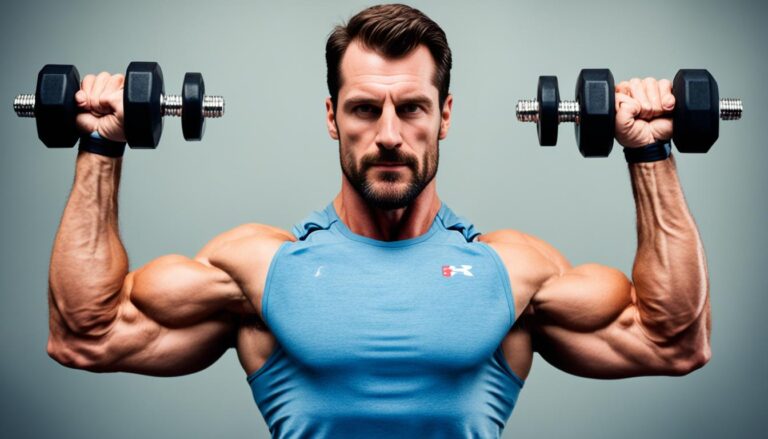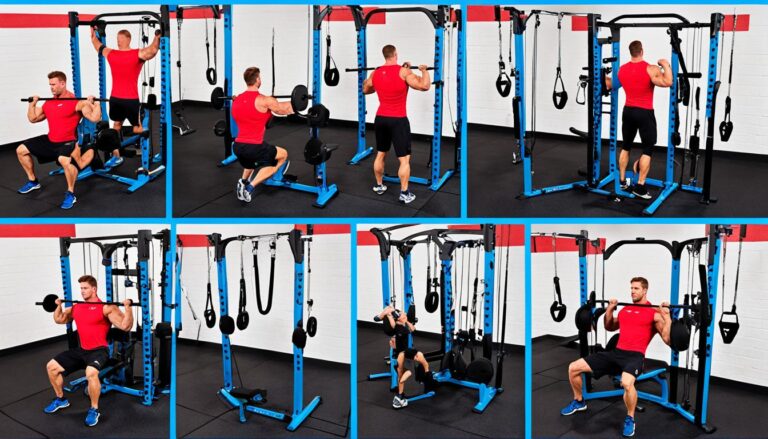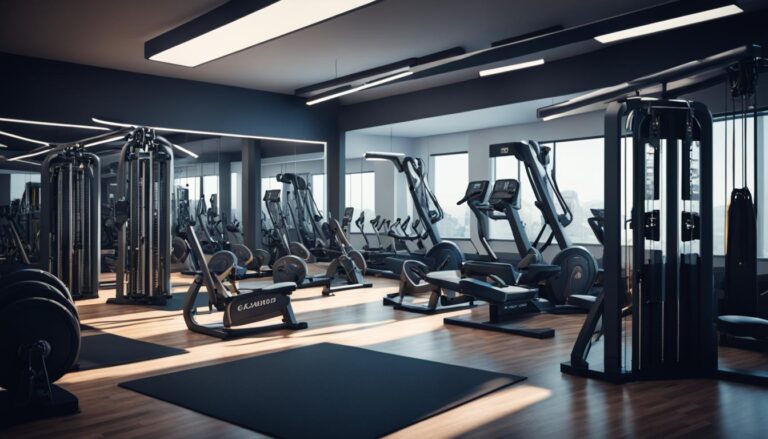Are you aiming to enhance your chest strength and develop a more muscular physique? Look no further. In this article, I will guide you through essential barbell chest workouts that promise efficient chest exercises tailored for both beginners and seasoned athletes. The right chest strength training regimen can significantly impact your overall upper body development, leading to noticeable muscle growth and strength improvements.
Whether you are a gym enthusiast or a newcomer, understanding the proper techniques and exercises is crucial. Let’s dive into the world of barbell chest workouts and uncover the secrets to building a powerful chest.
Key Takeaways
- Barbell chest workouts are effective for developing both strength and size.
- Proper technique is essential for maximizing results and preventing injury.
- Different variations, such as incline and decline presses, target various parts of the chest.
- Consistency and progressive overload are key to significant strength gains.
- Integrating these exercises into a balanced routine enhances overall chest development.
Introduction to Chest Workouts with a Barbell
When embarking on the journey of Chest Hypertrophy Training, the barbell stands out as a quintessential element. Understanding the fundamentals of *Barbell Chest Training* sets the foundation for muscle growth and strength gains. This exploration into starting chest workouts delves into the necessary equipment and the crucial basics that beginners need to master.
Utilizing a barbell in chest workouts offers several advantages. For one, it ensures that both sides of the body work in unison, promoting balanced muscle development. Additionally, barbell exercises allow for incremental loading, which is key to progressive overload, an essential principle in Chest Hypertrophy Training.
Before diving into the specifics of Barbell Chest Training, assemble the necessary equipment: a sturdy bench, quality barbells, and an assortment of weight plates. Proper setup not only ensures safety but also maximizes the effectiveness of your workouts.
- Barbell: Essential for loading weight and ensuring uniform muscle engagement.
- Bench: Provides stability and support, whether flat, inclined, or declined.
- Weight Plates: Allows for gradual progression in weight, crucial for muscle adaptation.
For those just starting chest workouts, it’s vital to focus on mastering form and technique. This will not only prevent injuries but also lay the groundwork for effective muscle development.
One cannot overemphasize the role of consistency and patience in Barbell Chest Training. Results stem from a dedicated approach, tailored progressively to match one’s increasing strength and endurance.
| Equipment | Benefits | Considerations |
|---|---|---|
| Barbell | Uniform muscle engagement, scalable weight | Ensure proper weight selection and balance |
| Bench | Stability, various angles for targeted training | Adjust according to exercise (flat/incline/decline) |
| Weight Plates | Progressive overload, adaptability | Increment weights to match strength progression |
Embarking on your Chest Hypertrophy Training with the right approach and equipment paves the path to achieving your fitness goals. Remember, every journey begins with a single step – make yours count with thoughtful and effective barbell work.
Importance of Barbell Exercises in Chest Training
Understanding the significance of barbell exercises is crucial for anyone aiming for an Optimal Chest Workout. Barbell movements not only target the major chest muscles but also engage several stabilizer muscles, enhancing overall Muscular Development.
Muscle Engagement
Barbell exercises offer a high degree of muscle engagement. The fixed bar path demands precise control, recruiting stabilizer muscles that are often neglected in other exercise modalities. This recruitment leads to a comprehensive chest workout, fostering balanced Muscular Development and reducing the risk of muscle imbalances.
Strength Gains
One of the primary benefits of incorporating barbells into your chest routine is the associated Strength Enhancement. The ability to progressively overload the muscles with heavier weights is unprecedented with barbell exercises. This constant progression challenges the muscles, resulting in significant Strength Gains and optimal chest development.
Standard Barbell Bench Press
The standard barbell bench press is one of the most classic chest exercises, crucial for building upper body strength and muscle mass. Mastering the Bench Press is not only about lifting heavy weights but also about ensuring proper form and technique to maximize results and prevent injuries. Let’s dive into the essential components of this exercise to help you improve your Bench Press Technique and avoid common mistakes.
Proper Form and Technique
To achieve the best results with the bench press, it’s vital to focus on proper form and technique. Here are step-by-step instructions:
- Positioning: Lie flat on a bench with your feet firmly planted on the ground. Your eyes should be directly under the barbell.
- Grip: Use a medium grip, with hands slightly wider than shoulder-width apart. This grip optimizes muscle engagement.
- Unracking the Bar: Lift the barbell off the rack and hold it straight over your shoulders, arms fully extended.
- Lowering the Bar: Slowly lower the barbell to the middle of your chest, ensuring your elbows are at a 90-degree angle.
- Pushing Up: Drive the barbell upward, using your chest muscles, to return to the starting position.
- Breathing: Inhale as you lower the bar and exhale as you push it up.
Perfecting these steps will help you avoid common pitfalls and enhance your Bench Press Technique. For additional muscle engagement and to correct possible muscle imbalances, consider incorporating cable workouts into your routine.
Common Mistakes
When performing the bench press, it’s easy to make subtle errors that can impact your progress and increase injury risk. Here are some common mistakes to watch out for and how to avoid them:
- Incorrect Grip Width: A grip too wide or too narrow can lead to shoulder or wrist injuries. Always ensure you use the proper medium grip.
- Avoiding Arching Back: Keep your back flat against the bench. An excessively arched back can strain your spine.
- Not Engaging Core: Tighten your core to stabilize your body, which will prevent unnecessary movement during the lift.
- Rushed Movements: Perform the exercise in a controlled manner. Rushing can lead to improper form.
- Neglecting Warm-Up: Warming up is crucial to prepare your muscles and joints, helping to prevent injuries.
By being mindful of these mistakes, you can focus on Avoiding Bench Press Mistakes and create a safer, more efficient workout. Perfecting the Bench Press Technique ensures you are utilizing your training time effectively, paving the way for significant strength and muscle gains.
Mastering the Bench Press isn’t just about following a set of instructions but also about understanding the dynamics of the exercise and continuously refining your form and technique.
Incline Barbell Bench Press
The Incline Barbell Bench Press is a quintessential exercise for achieving comprehensive upper chest development. Unlike the flat bench press, this angled chest exercise targets the upper pectoral muscles by shifting the angle of the bench to around 30-45 degrees. This position recruits more muscle fibers in the upper chest compared to flat and decline variations, making it an indispensable part of any robust chest training regimen.
The main advantage of the incline barbell bench press is its ability to counteract the often neglected upper chest, which many lifters focus on less.

When talking about incline press benefits, it is worth noting the enhanced range of motion and increased muscle activation it offers. Additionally, this form of pressing can help mitigate shoulder strain posed by other bench press variations.
Incorporating the incline pressinto your workout can effectively round out your chest development, addressing the entirety of the pectoral muscle group. Here is a comparison of the effectiveness of various bench press angles:
| Exercise | Muscle Focus | Main Benefits |
|---|---|---|
| Flat Bench Press | Middle Chest | Overall Strength, Mass Building |
| Incline Bench Press | Upper Chest | Upper Chest Development, Enhanced Muscular Definition |
| Decline Bench Press | Lower Chest | Improved Lower Chest Shape, Shoulder Relief |
To maximize the gains, I always recommend using a spotter during heavy sets and ensuring proper form. The execution should involve maintaining a controlled motion, keeping your shoulder blades retracted, and avoiding excessive arching of the lower back.
- Set the bench at a 30-45 degree angle.
- Grip the barbell slightly wider than shoulder-width.
- Lower the bar to the upper chest in a controlled manner.
- Press back up to full arm extension, engaging the upper pectorals.
Leveraging the benefits of the incline barbell bench press will help sculpt a balanced and powerful chest profile, fortifying your overall upper body strength and aesthetics.
Decline Barbell Bench Press
The decline barbell bench press is a crucial component of a well-rounded chest workout regimen. By positioning the body at a downward angle, this exercise uniquely engages the lower chest muscles, offering a beneficial variation to traditional flat and incline presses.
Targeted Muscles
During a decline barbell bench press, the primary muscles targeted include the pectoralis major with an emphasis on its lower fibers. Additionally, the anterior deltoids and triceps brachii play a supportive role in the movement. This targeting ensures that lower chest exercises such as the decline press are especially effective for sculpting a well-defined and balanced chest.
Effective Variations
To diversify your workout and overcome any training plateaus, consider incorporating different decline press techniques and bench press variations. Popular options include:
- Decline Dumbbell Press: Utilizes dumbbells instead of a barbell, allowing for a greater range of motion and individual arm strength development.
- Decline Smith Machine Press: Offers guided stability, making it an excellent choice for isolating the lower chest muscles safely.
- Reverse Grip Decline Press: Flipping your grip targets the upper portion of the lower pectoral fibers, providing a unique angle of muscle engagement.
Implementing these variations ensures a comprehensive approach to lower chest exercises, maximizing the overall effectiveness and aesthetic appeal of your chest workout routine.
Barbell Workouts for Chest to Maximize Strength
Maximizing your chest strength through barbell workouts is a science in itself. This section delves into the essential aspects: selecting the right weight, and understanding training volume and workout frequency to achieve optimal strength workouts.
Choosing the Right Weight
The key to successful chest training lies in choosing the appropriate weight. It’s critical to balance the weight you lift to ensure you challenge your muscles while maintaining proper form. Lifting too heavy can compromise technique, risking injury, while lifting too light may not stimulate sufficient muscle growth.
To identify the right weight, start with a manageable load and progressively increase it until you find a weight that allows you to complete your sets with moderate difficulty, typically within the range of 8-12 repetitions. This sweet spot ensures you’re working your muscles effectively without overexerting yourself in the process.
Volume and Frequency
Optimizing training volume and workout frequency is crucial for substantial strength gains. Training volume, represented by the total number of sets and repetitions performed, should be tailored to your current fitness level and goals. A common approach is to aim for 12-20 sets per week for the chest, divided across 2-3 sessions. This strategy allows for sufficient stimulus and recovery, which are both necessary for muscle growth.
Furthermore, workout frequency—how often you train your chest each week—should be calibrated to avoid overtraining. For most individuals, working the chest 2 to 3 times a week provides an ideal balance. This frequency ensures that your muscles are repeatedly stimulated for growth while also receiving adequate recovery time, thereby enhancing the efficacy of your optimal strength workouts.
A balanced approach, considering training volume and workout frequency tailored to individual capabilities, can significantly progress your chest strength over time.
Barbell Pullovers for Comprehensive Chest Development
Barbell pullovers are an excellent addition to any full chest workout. The barbell pullovers technique uniquely targets the chest muscles, promoting substantial chest development and thoracic cavity expansion.
To perform barbell pullovers correctly, lie flat on a bench with your feet firmly planted on the ground. Grasp the barbell with a shoulder-width grip, extend your arms straight, and carefully bring the barbell overhead until it aligns with your chest. From this position, lower the barbell in an arc over your head while maintaining a slight bend in your elbows. Engage your core and chest muscles as you bring the barbell back to the starting position.
Incorporating barbell pullovers into your routine offers several benefits:
- Expanded Thoracic Cavity: This exercise uniquely expands the thoracic cavity, enhancing lung capacity and overall respiratory function.
- Comprehensive Muscular Engagement: It fully engages the chest muscles, aiding in achieving a fuller, more developed upper body appearance.
- Versatility: The barbell pullovers technique is versatile, allowing it to be integrated into various chest expansion exercises.
Here’s a comparison of barbell pullovers with other chest exercises:
| Exercise | Primary Muscle Group | Secondary Benefits |
|---|---|---|
| Barbell Pullovers | Chest | Thoracic Expansion |
| Barbell Bench Press | Chest | Upper Body Strength |
| Incline Bench Press | Upper Chest | Front Shoulder Development |
Incorporate barbell pullovers into your full chest workout for substantial chest growth and improved muscle engagement. Understanding the correct barbell pullovers technique will enable you to maximize the benefits of your chest expansion exercises, leading to a well-rounded and effective chest workout routine.
Maximizing Hypertrophy with Barbell Flyes
To ensure a highly effective Chest Isolation Workout, integrating barbell flyes into your fitness routine can yield significant benefits. Barbell flyes are excellent for targeting the pectoral muscles, thereby maximizing hypertrophy. When executed correctly, they provide a unique advantage in your workout regimen.
Correct Execution
Executing barbell flyes with proper form is critical to ensure you are effectively isolating the chest muscles. Here are some key steps for correct execution:
- Lie flat on a bench, holding the barbell with an overhand grip.
- Maintain a slight bend in your elbows to reduce strain on your joints.
- Slowly lower the barbell in an arc, feeling a stretch in your chest.
- Inhale during the lowering phase and pause briefly at the bottom.
- Exhale as you bring the barbell back to the starting position using the same arc motion.
Adhering to these steps ensures you maximize the Chest Isolation Workout by maintaining control and preventing injuries.
Benefits Over Dumbbell Flyes
The Barbell Flyes Advantages over their dumbbell counterparts lie in the consistent motion and controlled path provided by the barbell. Here are some notable benefits:
- Barbell flyes offer a better balance due to holding a single bar, reducing the risk of asymmetric muscle development.
- Increased stabilization and controlled motion ensure effective muscle engagement, enhancing hypertrophy.
- Suitable for progressive overload, barbell flyes make it easier to add weight and track strength gains.
Incorporating barbell flyes can serve as a powerful complement to other pressing movements in your chest workouts. The steady resistance and controlled variations provided by barbell flyes make it easier to focus on Hypertrophy Tips and maximize chest development. For more insights on the benefits of different workout equipment, you can explore a comparison of cable machine exercises and free.
Incorporating Powerlifting Techniques in Chest Workouts
Harnessing the principles of powerlifting can significantly enhance your chest workouts, merging strength and size goals with Power Building Regimens. By focusing on Powerlifting Chest Techniques, you can leverage the compound movements that are staples in the powerlifting community to improve your overall chest development.
The foundation of integrating these techniques lies in the understanding of Strength Training Principles. In powerlifting, exercises like the bench press are not only performed to lift heavy but also to build endurance and muscle thickness. This involves strict adherence to proper form, strategic weight progression, and consistent volume adjustments.
Incorporating such techniques in your chest workouts requires adopting a methodical approach. Initiate with traditional compound lifts such as the flat bench press, which allows you to maximize chest engagement through controlled movements and heavy loads. According to Barbell Medicine, even simple variations like the incline bench press can produce substantial gains, provided the technique aligns with powerlifting standards.
Another critical aspect is the development of Power Building Regimens, which combine hypertrophy and strength cycles. These regimens ensure that your chest workouts are not only about lifting maximum weights but also about promoting muscle growth through higher volume sets.
Consider a structured weekly plan that includes elements of both powerlifting and bodybuilding. This hybrid approach leverages the best of both worlds, creating a powerful and sculpted chest through disciplined and strategic training. Adapting these methods will help you achieve a balance between strength and aesthetics, optimizing your chest workouts for maximum gains.
Advanced Barbell Training Techniques for Chest
When advancing in chest workouts, incorporating various advanced barbell training techniques can significantly challenge the muscles and push them towards consistent growth. These methods ensure that your chest training remains progressive and helps to prevent plateaus.
Progressive Overload
The Progressive Overload Strategy is fundamental for continuous muscle growth. By incrementally increasing the weight or the number of repetitions, you consistently challenge your muscle fibers. It’s essential to keep accurate records of your lifts to ensure steady progression.
Time Under Tension
Implementing Time Under Tension Workouts focuses on the duration your muscles are actively engaged during each set. This technique involves slower, controlled lifts that maximize muscle engagement and promote hypertrophy. Aim to extend each rep to 3-5 seconds for optimal results.
Supersets and Dropsets
Intensity Boosting Techniques like supersets and dropsets can greatly enhance the effectiveness of your chest workouts. Supersets involve performing two exercises back-to-back without rest, targeting different or the same muscle groups. Dropsets, on the other hand, involve performing a set to failure, then reducing the weight and continuing the set to further fatigue the muscles.
By incorporating these advanced techniques, you can ensure that your chest workouts remain effective and challenging. Here’s a comparison table outlining the features and benefits of these techniques:
| Technique | Primary Focus | Benefits |
|---|---|---|
| Progressive Overload | Increasing Weight/Reps | Consistent Muscle Growth |
| Time Under Tension | Duration of Muscle Engagement | Enhanced Hypertrophy |
| Supersets/Dropsets | Intensity Boost | Greater Muscle Fatigue |
Common Mistakes to Avoid in Barbell Chest Workouts
Barbell chest workouts are highly effective, but only when performed correctly. To maximize gains and minimize risks, it is crucial to avoid certain workout mistakes that can impede progress and cause injuries.
Improper Grip Width
One of the most common workout mistakes is using an improper grip width during exercises like the bench press. The importance of proper grip techniques cannot be overstated, as incorrect hand placement can lead to joint strain and suboptimal muscle engagement. To achieve the best results, ensure your grip is neither too wide nor too narrow. This balance allows for efficient distribution of weight and better activation of the chest muscles.
Neglecting Recovery
Another significant error is neglecting recovery. The importance of recovery in a fitness routine is often overlooked, yet it is essential for strength and muscle growth. Skipping recovery periods can lead to overtraining, reducing your overall performance and increasing the risk of injury. Implementing adequate rest periods between workouts allows your muscles to repair and grow, making your training more effective in the long run.
Below is a simple comparison to highlight the effects of improper grip width and neglecting recovery on barbell chest workouts.
| Workout Error | Consequences | Solutions |
|---|---|---|
| Improper Grip Width | Joint Strain, Suboptimal Muscle Engagement | Adopt proper grip techniques to enhance muscle activation |
| Neglecting Recovery | Overtraining, Increased Injury Risk | Emphasize the importance of recovery with adequate rest periods |
Creating a Balanced Barbell Chest Workout Routine
Designing a balanced training routine for your chest with barbell exercises fosters not only muscle growth but also overall fitness. It’s important to structure your workout thoughtfully, incorporating proper warm-up and cool-down routines and ensuring overall body balance.
Warm-up and Cool-down
One cannot overstate the significance of warm-up essentials before diving into intense bench presses or any chest-specific exercises. Proper warm-ups may include dynamic stretches, light cardio, and sub-maximal sets to prepare your muscles and joints.
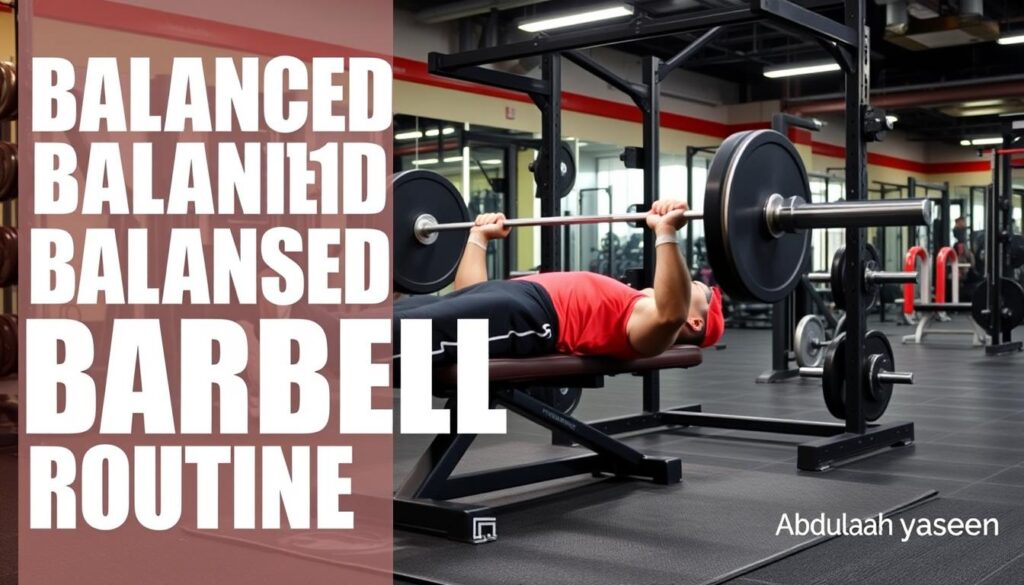
Equally crucial are the cool-down benefits post-workout. Gentle stretching and light aerobic activities can reduce muscle stiffness and expedite recovery. This helps in enhancing overall workout performance and reducing injury risks.
Integration with Full Body Workout
Integrating chest workouts into a full-body regimen ensures a holistic approach to fitness. A well-rounded exercise plan guarantees uniform muscle development. To optimize chest workout integration, one might consider organizing the training week strategically. For example, alternating between lower body and upper body days allows adequate rest and growth for each muscle group.
- Day 1: Chest-focused session with barbell exercises
- Day 2: Lower body and core workouts
- Day 3: Rest or active recovery with light cardio
- Day 4: Back and shoulders
- Day 5: Full-body conditioning
- Day 6: Rest or yoga
- Day 7: Mixed light workouts
Following such a balanced training routine not only improves chest muscle definition but also contributes to the overall strength and endurance of the body. Thus, creating a well-structured and comprehensive plan is paramount for effective and sustained fitness progress.
Conclusion
In conclusion, barbell workouts are integral for those committed to achieving chest strength and hypertrophy. Throughout this article, I highlighted various barbell exercises ranging from the standard bench press to advanced training techniques. These exercises are fundamental for muscle engagement and strength gains, allowing for a more well-rounded and robust chest development.
Delving into workouts like the incline and decline barbell bench press, as well as incorporating barbell pullovers, provides diversified angles to target different chest fibers. This diversification is crucial in a balanced workout routine, ensuring every part of the chest is engaged. Techniques such as progressive overload, time under tension, and incorporating powerlifting methods further amplify these benefits.
Finally, the importance of avoiding common mistakes and maintaining proper form cannot be overstated. Simple missteps like improper grip width or dismissing recovery can hinder progress. Remember, the key to success lies in a well-structured regimen coupled with the knowledge shared here. Embark on your journey toward chest strength and aesthetic development with confidence, armed with these training takeaways.
FAQ
What are the key benefits of incorporating barbell chest workouts into my routine?
Barbell chest workouts are highly effective for increasing chest strength and muscle hypertrophy. They allow for greater muscle engagement, enhanced strength gains, and optimal development of the pectoral muscles.
How should I start chest workouts with a barbell as a beginner?
As a beginner, it’s important to focus on mastering the basics such as the standard barbell bench press, ensuring you have the correct form and technique. Start with lighter weights and gradually increase the load as you become more comfortable with the movements.
Why is proper form and technique crucial in barbell bench press exercises?
Proper form and technique are essential to maximize efficiency, prevent injuries, and ensure safety. Incorrect form can lead to muscle imbalances and place unnecessary stress on joints and muscles.
What specific muscles does the incline barbell bench press target?
The incline barbell bench press specifically targets the upper pectoral muscles, providing a more rounded chest development compared to flat and decline bench presses. It emphasizes the clavicular head of the pectoralis major.
What is the significance of decline barbell bench press in a chest workout?
The decline barbell bench press focuses on the lower part of the chest, effectively targeting the sternal head of the pectoralis major. It is essential for achieving full chest muscle development.
How can I maximize strength gains in my barbell chest workouts?
To maximize strength gains, it’s important to choose the right weight, balance workout volume and frequency, and progressively overload your muscles by increasing the weight or reps over time.
What are barbell pullovers and how do they benefit chest development?
Barbell pullovers are an excellent exercise for comprehensive chest development. They help expand the thoracic cavity, promoting overall chest muscle hypertrophy and enhancing upper body flexibility.
Are barbell flyes more effective than dumbbell flyes for chest hypertrophy?
Barbell flyes offer unique advantages over dumbbell flyes by allowing for a more stable range of motion and targeting the chest muscles with a different stimulus. They can be an effective complement to other chest exercises for hypertrophy.
How can I incorporate powerlifting techniques into my chest workouts?
Incorporating powerlifting techniques, such as focusing on low-rep heavy lifting and compound movements, can significantly enhance chest strength and development. These techniques build a solid foundation of strength that benefits overall muscle growth.
What is progressive overload and how does it apply to barbell chest training?
Progressive overload involves gradually increasing the weight, reps, or intensity of exercises to continuously challenge the muscles. In barbell chest training, it ensures ongoing muscle growth and strength gains.
What are common mistakes to avoid in barbell chest workouts?
Common mistakes include improper grip width, which can strain joints and muscles, and neglecting recovery, which can lead to overtraining and hinder progress. Focus on proper technique and incorporate adequate rest periods.
How can I create a balanced barbell chest workout routine?
A balanced barbell chest workout routine should include a mix of flat, incline, and decline presses, along with accessory movements like barbell flyes and pullovers. Always incorporate a proper warm-up and cool-down to ensure injury prevention and flexibility.

